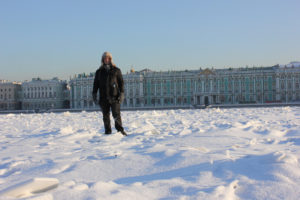My trek out to the Krasnogorsk suburb of Moscow, where the state television archive is housed, began at my desk in Los Angeles about three months in advance of my visit. An amazing amount of materials has been logged in a searchable online database, and I identified two dozen possible clips that seemed promising after a search for “Pushkin.” I sent my request by email to the administrator who deals with foreign requests.
One flight, subway and taxi ride later, I was at Krasnogorsk, in the yellow Russian mansion, where my pile of 24 reels was waiting.
There’s nothing like the thrill of discovering archival footage that fits perfectly into the film:
Throngs of Russians packed into Pushkin Square in 1937 to celebrate the 100th anniversary of Pushkin’s death.
Young red-scarfed trumpeters performing at the 1937 opening of Moscow School #353, The Pushkin School – where I had recently interviewed students and teachers.
A famous Russian actor reciting Pushkin’s “Exegis monumentum” on television. We inserted his beautiful, solemn voice into the film’s score.
Even better are the unexpected gems that I could have never imagined:
Factory workers producing small Pushkin busts by the dozen.
Welders and construction workers dismantling the Pushkin statue in Moscow’s Pushkin Square and moving it along rails to its new location
An ardent Party official opening a meeting with a vociferous glorification of Stalin and Pushkin, who together would take Russians to the “great heights of communism.”
Every old-school cannister was filled with a million frames of some of the most interesting historical materials imaginable. Sifting through Soviet history to find tidbits of Pushkin wasn’t the least bit tedious.

